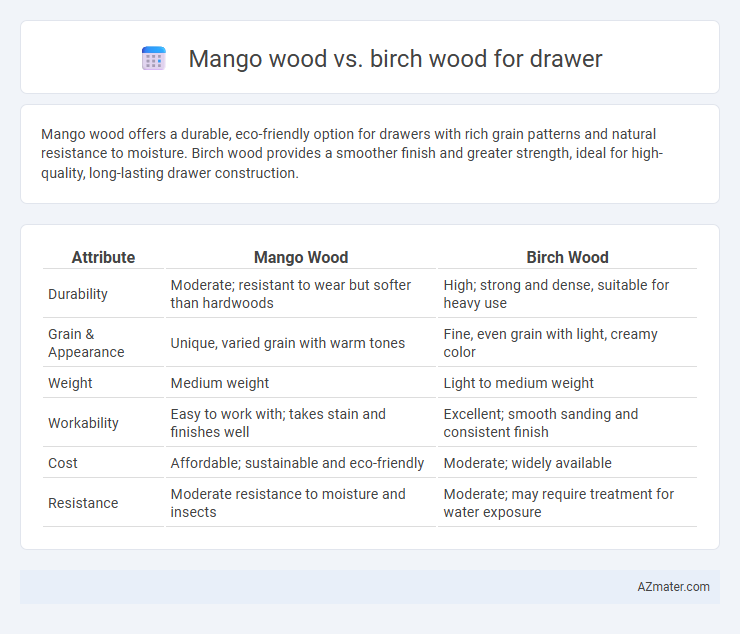Mango wood offers a durable, eco-friendly option for drawers with rich grain patterns and natural resistance to moisture. Birch wood provides a smoother finish and greater strength, ideal for high-quality, long-lasting drawer construction.
Table of Comparison
| Attribute | Mango Wood | Birch Wood |
|---|---|---|
| Durability | Moderate; resistant to wear but softer than hardwoods | High; strong and dense, suitable for heavy use |
| Grain & Appearance | Unique, varied grain with warm tones | Fine, even grain with light, creamy color |
| Weight | Medium weight | Light to medium weight |
| Workability | Easy to work with; takes stain and finishes well | Excellent; smooth sanding and consistent finish |
| Cost | Affordable; sustainable and eco-friendly | Moderate; widely available |
| Resistance | Moderate resistance to moisture and insects | Moderate; may require treatment for water exposure |
Introduction: Mango Wood vs Birch Wood for Drawers
Mango wood offers a dense, durable texture with natural resistance to moisture, making it an ideal choice for sturdy drawers that require longevity. Birch wood features a smooth grain and light color, providing a sleek, modern aesthetic while maintaining moderate durability suitable for everyday drawer use. Comparing mango wood's robustness and rich tone with birch wood's fine, pale finish helps determine the best material based on drawer function and interior design preferences.
Origins and Sustainability of Mango and Birch Wood
Mango wood, sourced from the tropical regions of India and Southeast Asia, is a highly sustainable option as it utilizes wood from mango trees that no longer bear fruit, reducing waste and deforestation. Birch wood, primarily harvested from North American and Northern European forests, is known for its fast growth rates and ability to regenerate, but responsible sourcing from certified sustainable forests is critical to minimize environmental impact. Both woods offer eco-friendly alternatives when sourced responsibly, with mango wood often favored for its repurposed material benefits and birch prized for its renewability in managed forests.
Appearance and Grain Patterns
Mango wood features a rich, golden to reddish-brown hue with unique, irregular grain patterns that add a rustic and warm character to drawers. Birch wood displays a lighter, creamy color with a smooth, fine, and consistent grain, offering a clean and modern aesthetic. Both woods provide distinctive visual appeal, with mango wood highlighting natural variations and birch wood emphasizing uniformity and subtle elegance.
Strength and Durability Comparison
Mango wood offers excellent strength and natural resistance to wear, making it highly durable for drawer construction. Birch wood features a tight grain and high density, providing superior hardness and long-lasting structural integrity. Both woods are strong, but birch generally outperforms mango in load-bearing durability and resistance to dents.
Workability and Ease of Crafting Drawers
Mango wood offers excellent workability due to its medium density and fine grain, allowing for smooth cutting and shaping, making it ideal for crafting detailed drawer components. Birch wood is known for its hardness and uniform texture, providing superior durability but requiring sharper tools and more effort during woodworking. Both woods are suitable for drawer construction, but mango wood tends to be easier to work with for complex designs, while birch offers a sturdier finish with slightly more challenging crafting.
Cost and Availability
Mango wood generally costs less than birch wood, making it a budget-friendly choice for drawers without compromising durability. It is widely available due to mango trees being cultivated in tropical regions, whereas birch wood is more common in temperate climates and can be pricier depending on local supply. The consistent availability of mango wood supports competitive pricing, while birch wood's cost fluctuates with regional demand and forestry regulations.
Resistance to Moisture and Pests
Mango wood exhibits moderate resistance to moisture and natural oils, making it relatively durable against humidity but requires proper sealing to prevent warping in drawers. Birch wood has a lower natural resistance to moisture and is more susceptible to water damage and swelling, necessitating thorough finishing and maintenance for drawer applications. Both woods are vulnerable to pests without treatment, but mango wood's denser grain provides a slight advantage in pest resistance compared to birch.
Maintenance and Care Requirements
Mango wood drawers require regular oiling to maintain their natural luster and prevent drying or cracking, benefiting from a soft cloth wipe to remove dust and prevent buildup. Birch wood drawers have a smoother finish and generally need less frequent maintenance, with occasional polishing to protect against moisture and scratches. Both woods should be kept away from direct sunlight and excessive humidity to avoid warping and discoloration, ensuring longevity and durability.
Environmental Impact and Eco-Friendliness
Mango wood is renowned for its sustainability, as it utilizes timber from trees that have already fulfilled their fruit-producing lifecycle, reducing deforestation impact compared to harvesting birch wood from slower-growing hardwood forests. Birch wood, while durable and visually appealing, often comes from commercially logged forests, which may contribute to habitat loss and slower regeneration rates, raising environmental concerns. Choosing mango wood for drawers supports eco-friendly practices by promoting the use of renewable resources and minimizing ecological footprint through responsible wood sourcing.
Which Wood is Best for Your Drawer?
Mango wood offers durability and rich grain patterns, making it an excellent choice for sturdy drawers with a unique appearance. Birch wood provides a smooth, fine texture and light color, ideal for drawers requiring a clean, contemporary look with good strength. For long-lasting, aesthetically versatile drawers, mango wood is best suited, while birch wood excels in modern, minimalist designs.

Infographic: Mango wood vs Birch wood for Drawer
 azmater.com
azmater.com